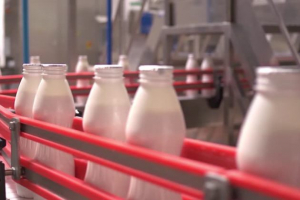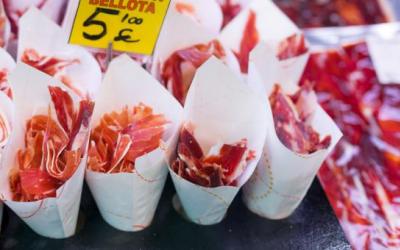Annual inflation accelerated in Russia

 PIONEER MEIZHENG BIO-TECH (5 in1) JC0871/ Rapid tests for the determination of the residual amount of β-lactams, tetracyclines, chloramphenicol, streptomycins, ceftiofur in milk, whey.
PIONEER MEIZHENG BIO-TECH (5 in1) JC0871/ Rapid tests for the determination of the residual amount of β-lactams, tetracyclines, chloramphenicol, streptomycins, ceftiofur in milk, whey. Rapid tests for fluoroquinolone, erythromycin, lincomycin, tillosin and tilmycosin residues in milk, whey
Rapid tests for fluoroquinolone, erythromycin, lincomycin, tillosin and tilmycosin residues in milk, whey
In January-February 2024 , without taking into account the seasonal rise in prices for fruits and vegetables, dairy products increased in price the most , says Denis Ternovsky, a researcher at the Center for Agricultural Policy of the Institute of Economics and Public Administration of the Russian Presidential Academy of National Economy and Public Administration. Thus, over two months, pasteurized MILK increased in price by 2.1%, butter - by 3.2%. In addition, banana prices continued to rise. According to him, the rise in price of these products was expected - milk prices are now 4% below the average values of previous years, taking into account general inflation, producers are trying to compensate for this gap. The rise in banana prices continues to reflect the weakening of the ruble in 2023 and the rise in world prices for this product.
Senior analyst at the Center for Economic Forecasting of Gazprombank Daria Tarasenko said that since the beginning of 2024, price growth has remained above the target level of the Bank of RUSSIA. On the part of structural factors for inflation dynamics, problems in the labor market, rising costs of logistics, volatility of the ruble exchange rate are still relevant - production costs put pressure on prices. The expert expects that in the base scenario, average annual inflation in 2024 will be 8%. The main effect of tightening monetary policy will be observed in the segments of non-food goods and services (since these goods are more dependent on the rate of lending to the population), demand for food products will remain stable in 2024.
it is unlikely that prices will decline in March, said a representative of the analytical department of Svoy Bank JSC (IDF Eurasia Group). “Against this background, we expect that the Bank of Russia will not rush to lower the key rate. Theoretically, in order to further curb price growth, the Central Bank could even slightly increase the rate, as reported after the February meeting, but this is still an unlikely scenario,” says the bank’s analyst.
He noted that one of the reasons for inflation is the increase in enterprise costs. The high rate of the Bank of Russia leads to an increase in the cost of loans - banks can no longer attract inexpensive funding and provide loans to borrowers at more favorable rates. According to Central Bank statistics, the weighted average rate on loans provided to organizations for a period of more than three years in December 2023 was 13.86%. In the context of decreasing availability of borrowed funds, businesses have to fight costs and increase the cost of their products, correspondingly reducing affordability for the end consumer. Analysts at Svoy Bank expect that the key rate of the Bank of Russia will continue to put pressure on the lending market in 2024, since the regulator’s management has repeatedly noted that the transition to easing monetary policy will occur when the regulator sees a steady decline in inflation.
According to the updated forecast of the Bank of Russia, the average rate in 2024 is expected to be 13.2-15.5%, which is 1 p.p. higher than the previous forecast. The Central Bank regularly points to ongoing inflationary pressures and the persistence of elevated inflation expectations and emphasizes that returning inflation to the target of 4-4.5% in 2024 requires a prolonged period of tight monetary policy, and therefore high rates. “But we still believe that towards the end of the first half of 2024, the Bank of Russia will begin to gradually reduce the key rate,” concluded Svoy Bank analysts.
Olga Belenkaya, HEAD of the macroeconomic analysis department of Finam Financial Group, says that the slowdown in weekly price growth was largely influenced by the dynamics of volatile components - prices for fruits and vegetables and air travel. In general, the current inflation rate relative to the previous period since December last year has slowed significantly compared to the peak values of the autumn months (to approximately 5-7% annualized, taking into account seasonality, versus 10-11% in the fall). According to the expert, the slowdown in inflation is influenced by the stabilization and slight strengthening of the ruble exchange rate since October last year and the strict monetary policy of the Bank of Russia.
As for the acceleration of inflation in annual terms relative to the same month of last year, it is still continuing due to the base effect of last year, and this effect may continue until the end of the second quarter. In July, housing and communal services tariffs will be indexed (for the first time since December 2022), the average increase in Russia will be 9.8%, which may make a short-term contribution to inflation this month. Since August, Finam expects a slowdown in annual inflation rates, and at the end of the year the figure will be in the range of 5-5.5%. “However, the inflation forecast always depends on many factors that are now difficult to predict. This is a possible increase in budget expenses compared to the approved values, administrative decisions on additional tariffs and fees, the dynamics of the ruble exchange rate, additional logistics costs in foreign trade, agricultural harvests and food prices in Russia and in the world,” Belenkaya concluded.
Read together with it:
- С начала года Московская область увеличила экспорт свинины на 35% в стоимостном выраженииМосковская область продолжает укреплять позиции одного из ведущих экспортеров продукции агропромышленного комплекса в России. По итогам 9 месяцев с начала года регион нарастил экспорт свинины на 35% по стоимости. В натуральном выражении объем поставок составил 85 тысяч тонн, что на 17% больше, чем за аналогичный период прошлого года. В Министерстве сельского хозяйства и продовольствия Московской о...
- В Татарстане за 9 месяцев 2025 года произведено 314 тыс. тонн мяса скота и птицы, надоено 1 млн 405 тыс. тонн молокаВ Республике Татарстан на сегодня выкопано 42 тыс. га площадей сахарной свеклы, это 79% от плана. Накопано свыше 2 млн. тонн корнеплодов со средней урожайностью 490 ц/га. Сахарными заводами заготовлено 667 тыс. тонн, переработано 593 тыс. тонн сырья, выработано 82 тыс. тонн сахара. Такие данные привел заместитель Премьер-министра РТ – министр сельского хозяйства и продовольствия РТ Марат Зяббаров ...
- Московская область демонстрирует рост урожая зерновых, картофеля и овощей в 2025 годуВ Московской области отмечается положительная динамика по валовому сбору ключевых сельскохозяйственных культур. Значительно увеличены показатели по зерновым и зернобобовым, картофелю и овощам. В Министерстве сельского хозяйства и продовольствия Московской области сообщают, что валовой сбор зерновых и зернобобовых культур составил 592,2 тыс. тонн, что на 89,9 тыс. тонн или 18% превышает показатель ...
- Беларусь и Алтайский край намерены увеличить биржевую торговлю сельхозпродукцией23 октября, Минск. Поставки белорусской мясомолочной продукции в Алтайский край и закупки зерна и семян для аграрного сектора Беларуси определены в качестве магистральных направлений сотрудничества в сфере электронной биржевой торговли. Такая договоренность достигнута по результатам встречи представителей Белорусской универсальной товарной биржи с делегацией деловых кругов Алтайского края, которая...
- Минчанин осужден за истязание беременной сожительницы23 октября, Минск. Суд Советского района Минска вынес приговор по уголовному делу об истязании беременной женщины. Об этом сообщает БЕЛТА со ссылкой на пресс-службу Минского городского суда.Обвиняемый систематически, с 13 июня 2024 года по 18 апреля 2025 года, будучи нетрезвым, наносил побои сожительнице, которая была беременна. Женщина из-за отсутствия личного заработка находилась в зависимом от ...
- Новое видео на нашем канале: Тысячи верблюдов под одним взглядом: как устроена смотровая площадка в конецентре Бауржана ОспановаРазговор с Бауржаном Кенесбековичем Оспановым о верблюдоводстве в Казахстане. Зачем казаху верблюд, как устроен конецентр и смотровая площадка где тысячи верблюдов проходят бонитировку. И снова, друзья мои, мы беседуем с известным казахстанским бизнесменом и меценатом Бауржаном Кенесбековичем Оспановым - человеком, который не просто развивает сельскохозяйственный бизнес, но делает это системно, с ...


























































